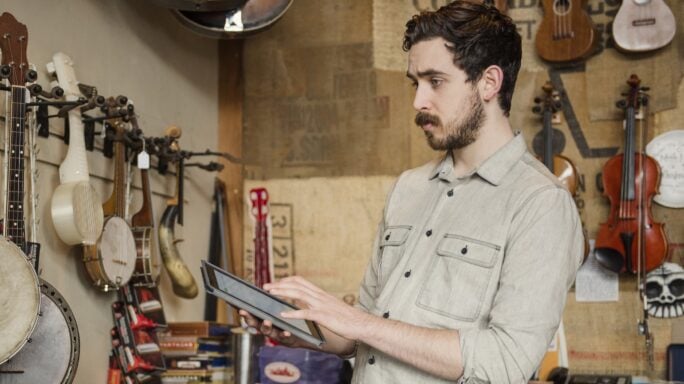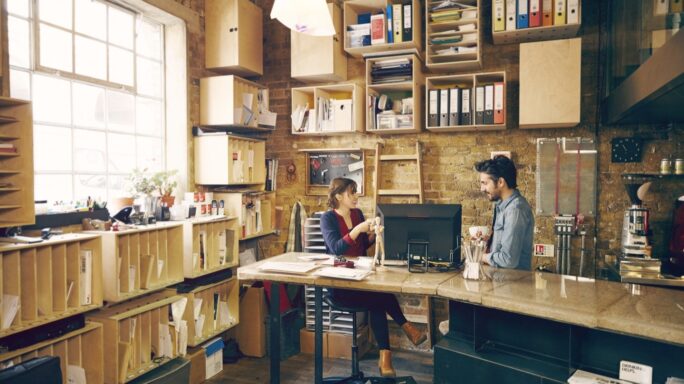Trending article
How much profit do coffee shops make annually?
Thinking of starting a coffee shop business? You may want to know the financial costs and profit estimates first. Read on to help you decide.

Thinking about opening your own coffee shop?
Before you consider running a café, you’ll need to get a solid idea of how much profit you can make.
In this article, we highlight how much coffee shop owners make, choosing locations, costs to be aware of, and plenty more.
Here’s what we cover in this article:
- How much do coffee shops make?
- How much do coffee shop owners make?
- Factors affecting your coffee shop’s revenue
- Choose your location
- So, can your coffee shop make money?
- Café costs to watch
- Other factors affecting your café’s profit
- How to keep your coffee shop in the black
- Keep in touch with your customers
- Final thoughts
How much do coffee shops make?
So, let’s start by doing some bean counting. How much do coffee shops make?
According to Project Café UK 2023, the branded coffee shop sector is worth £4.9bn, with 9,885 outlets in operation.
Most independent cafés start with little to no brand awareness, but these numbers show what you can achieve in this sector if you can build customer loyalty.
Branded coffee shops have big marketing budgets.
But independent shops can offer other a unique concept and character, while encouraging the community to shop local and support small businesses.
Business sales platform Bizdaq paints a more realistic picture of what you might achieve with a small independent offering.
It shows the average coffee shop turnover as between £100,000 and £150,000, with 22% of all cafes and coffee shops achieving this.
Around 5% have a turnover of up to £25,000, while 12% make over £250,000 with the rest spread out in between.
How much do coffee shop owners make?
According to Salary Expert, average salaries for a coffee shop manager are roughly £36,882 in the UK and £46,085 in London.
As an owner, you may be able to use anything left in the business to build cash reserves, reinvest or pay yourself a bit more.
The good news about coffee and tea is the raw ingredients are cheap and you can make a margin of up to 95% per cup.
This is much higher than the 60% you can usually get from food.
The less good news is coffee shop rent and labour is expensive, which leaves many with slim margins.
When it comes to selling a coffee shop, if you can build it to become saleable, the average value is £68,873, according to Bizdaq.
The average value of a cafe, which incorporates other elements such as a bar or restaurant, is £73,082.
But for the super ambitious, the sky is the limit.
Factors affecting your coffee shop’s revenue
Enough about national averages. How much are you likely to earn from your café idea?
Many factors come into play here, including:
- Brand and concept
- Location
- Customer footfall
- Sales volume
- Prices
- Costs (including start-up, fixed and variable operating costs)
Before you start grinding beans and working on your latte art, do some serious numbers crunching to get a realistic figure.
The more research and calculations you do, the better your business plan (or business model canvas if you’re using that instead) and chances of success.
Choose your location
Having an unusual concept for your café can certainly help drive sales, but this is hard to quantify. Location, however, is easier to analyse and important – some say crucial – to long-term success.
Factors such as being close to shops and offices, parking, access, pavements and street lighting are all worth considering.
Proximity to professional residential areas may also become a factor for people working from home (either on a full-time basis or part time via hybrid working).
Estimate footfall by discretely counting people as they walk past your proposed location at different times of day.
Observe similar coffee shops nearby, count the proportion who stop to buy something, and try to estimate average receipts from what they buy.
Use these estimates to forecast average receipts and daily revenues for your business. But be conservative and factor in whether your proposed location is desirable.
Also, carefully consider whether that area has the capacity to support another coffee shop, and that the market isn’t overly saturated with competitors.
If you fall in love with a location, but it doesn’t necessarily support a coffee shop on its own, consider combining it with another catering proposition, such a sandwich delivery service for local offices, or setting up stalls at festivals and community events.
Jim Winship, managing director of Food Events & Things, recommends newcomers go a step further and work for a coffee bar for six months to a year to understand as much about what they are getting into as possible, including how to make a profit.
So, can your coffee shop make money?
Time to get down to brass tacks.
Once you’ve chosen your location and settled on a brilliant concept, calculate your gross profit margin – sale minus cost of goods – on each product, and never lose focus on this.
According to St Martin’s Coffee Roasters, you must aim for a gross margin of 75%, which means selling everything for four times what it costs you in materials and ingredients.
For example, if a sandwich cost £1 to make, sell it for £4. If you can’t make this on a product, drop it.
There are specific VAT rules in place for catering, so make sure you factor them in where applicable. Adding 20% VAT would mean setting a final price of £4.80 to achieve your 75% margin on that sandwich.
Save time with a gross margin calculator or make the calculations using the tools available as part of your accounting software.
According to Limini Coffee, a typical receipt in the UK is £4.50.
At a 75% margin, you’d make £3.38 gross profit from that.
Say you have 12 customers an hour, that works out as 144 customers in a 12-hour day, equalling £487 gross profit a day.
This also has to cover fixed costs such as rent, staff salaries, utility bills, general expenses, and any loan repayments.
According to Coffee Central Roasting Company, typical fixed costs are £75 a day if you’re open seven days a week, which would leave you with £411 a day.
Your specific calculations will, of course, be different.
But you won’t understand your break-even point or be able to price your products accurately until you have done these calculations.
It’s also a good idea to keep a weekly profit and loss statement to make sure these calculations match reality.
Café costs to watch
To stay open 12 hours a day, you’ll need staff – and they are likely to be your largest overhead.
It’s vital to understand how much staff cost – including tax, pensions and any benefits – and how this eats into your turnover.
As a rough guide, keep staff costs under 30% of sales, and rent under 15%.
If either goes above that, start finding ways to cut costs or bump up sales.
Rent is your other big cost, so always negotiate with your proprietor, says Jim Winship.
“If you can renegotiate rent based on turnover, it’s more flexible,” he explains.
“It also means landlords have more interest in helping you and preserving the high street. Also, understand how each piece of equipment will contribute to your business.
“Don’t let anyone sell you fancy coffee machines you don’t need.”
Other factors affecting your café’s profit
When it comes to avoiding unnecessary costs, St Martin’s Coffee Roasters has a few more tips to share.
Make sure staff clock in and out when their shift starts and finishes, not when they arrive and leave the building. Use a staff scheduling app to understand how much a rota will cost and help you communicate rotas effectively.
Get a trustworthy electronic point of sale (ePOS) system to help you shape rotas for busy and quiet times. Keep a waste book and make it a business rule to record any wastage.
Do weekly stock takes to avoid wastage and check nothing is going missing.
Finally, manage inventory carefully and operate a just in time system designed to have the right level of inventory available at the right time.
How to keep your coffee shop in the black
If you plan for and run your business well, you can expect to make more money as you gain experience, train staff, build your brand, and increase the efficiency of your operation.
Customer loyalty will also grow over time, especially if you offer top-notch customer service and a loyalty card in place to sweeten the deal.
Still struggling to stay in the black?
Once you’ve optimised your cost basis, the main two factors you can try boosting are customer numbers and average receipts.
Since most café costs are fixed, attracting one more customer an hour or boosting average sales by £1 per sale could increase revenue significantly.
Consider selling higher-margin products, such as alcohol, low-prep plates and desserts you can make cheaply in-house such as ice-cream and cakes.
Incentivise your staff to upsell and cross-sell as much as possible without coming off as pushy to the customer.
Keep in touch with your customers
Your customers are at the centre of your business, so remember to get their feedback and use it to adapt your offering and stay competitive.
Ask them for their thoughts on your products and services, and show them you’re listening by making small, gradual changes to fit the evolving needs of your target market.
The best way to keep your revenue up is to build a loyal customer base and continue delighting them with quality products and excellent service.
Final thoughts
Now you have a good idea of how much profit coffee shops make annually, it’s time to factor your new-found knowledge into your planning.
If you’ve got designs on opening your own café, do your research on the location, consider your unique selling point(s), think about the overheads that need to be included, and remember that your customers are an important piece of the puzzle.
So grab yourself a coffee and build out your business plan, then take the steps to make your café a reality.
Editor’s note: This article was first published in May 2021 and has been updated for relevance.
Business plan template for food and drink companies
Want to create a business plan for your food or drink company but not sure how to do it? Download our free and easy-to-use business plan template and you can get started.








Ask the author a question or share your advice